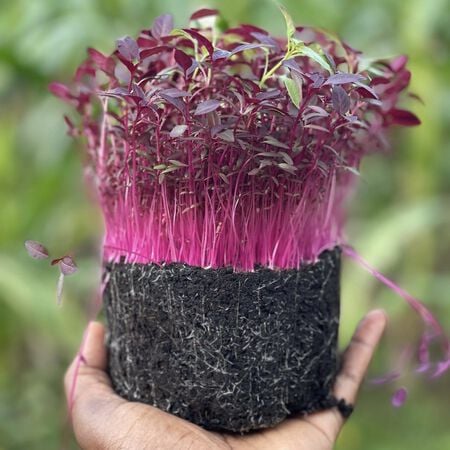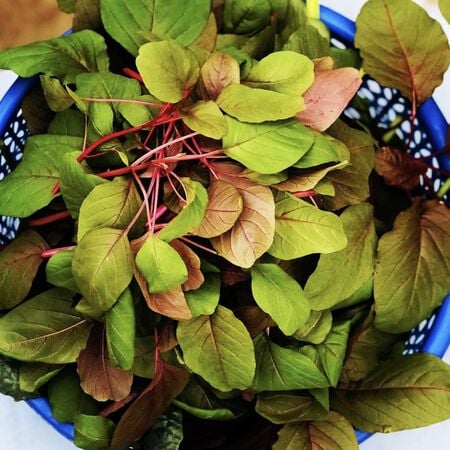Red Garnet Amaranth, Sprouts
Key Attributes
Product Details
Weight
.08Botanical Name
AmaranthusSeed Type
SeedBreed
Open-pollinatedLife Cycle
AnnualCategories
SproutDays To Maturity (# Days)
15Components
Growing Instructions
![]() Learning Download: How to Grow Sprouts
Learning Download: How to Grow Sprouts
Sprouting is a technique that uses water to germinate seeds, which are then eaten. Sprouts are a good option to grow for beginners, as they take only a week or two before they are ready to eat.
Before Planting: Sprouts may be grown in a clean, wide-mouth glass canning jar, sprouting tray or a commercial sprouter.
Planting: If sprouting in a glass jar, place the correct amount of seed in the glass jar. Cover the mouth of the jar with cheesecloth or other porous material, and secure with a rubber band. Fill the jar ½ full with lukewarm water and soak overnight. In the morning, drain off water. The cloth will keep the seeds in the jar. Rinse seeds with lukewarm water again and let drain. Put the container on its side in a dark location that stays about 60–70°F. At least twice each day, rinse with lukewarm water and drain. Continue rinse cycle until harvest.
Watering: Sprouts don’t require soil to grow, just water to germinate and a little bit of time before they are ready to consume.
Fertilizer: Fertilization is not necessary.
Days to Maturity: Since sprouts are ready for consumption in as little as a week to two weeks.
Harvesting: When sprouts have reached the desired length or have their first tiny green leaves, expose them to light for a few hours to color them up. Sprouts can be stored in the refrigerator for up to a week.
Tips: Precautions should be taken when consuming sprouts as they are grown in warm, moist conditions which also is the prime growing environment for bacteria such as E. coli and Salmonella. Sprouts are easily perishable, so refrigerate them and consume as quickly as possible. It is safest to cook the sprouts, as the heat will kill any bacteria growing there, and it is suggested that children, the elderly and anyone who is ill should not consume sprouts.
Shipping Schedule
Our Seed Promise
 "Agriculture and seeds" provide the basis upon which our lives depend. We must protect this foundation as a safe and genetically stable source for future generations. For the benefit of all farmers, gardeners and consumers who want an alternative, we pledge that we do not knowingly buy or sell genetically engineered seeds or plants.
"Agriculture and seeds" provide the basis upon which our lives depend. We must protect this foundation as a safe and genetically stable source for future generations. For the benefit of all farmers, gardeners and consumers who want an alternative, we pledge that we do not knowingly buy or sell genetically engineered seeds or plants.
The mechanical transfer of genetic material outside of natural reproductive methods and between genera, families or kingdoms, poses great biological risks as well as economic, political, and cultural threats. We feel that genetically engineered varieties have been insufficiently tested prior to public release. More research and testing is necessary to further assess the potential risks of genetically engineered seeds. Further, we wish to support agricultural progress that leads to healthier soils, to genetically diverse agricultural ecosystems, and ultimately to healthy people and communities.
To learn more about the "Safe Seed Pledge" please visit www.councilforresponsiblegenetics.org.
Key Attributes
Product Details
Weight
.08Botanical Name
AmaranthusSeed Type
SeedBreed
Open-pollinatedLife Cycle
AnnualCategories
SproutDays To Maturity (# Days)
15Components
Growing Instructions
![]() Learning Download: How to Grow Sprouts
Learning Download: How to Grow Sprouts
Sprouting is a technique that uses water to germinate seeds, which are then eaten. Sprouts are a good option to grow for beginners, as they take only a week or two before they are ready to eat.
Before Planting: Sprouts may be grown in a clean, wide-mouth glass canning jar, sprouting tray or a commercial sprouter.
Planting: If sprouting in a glass jar, place the correct amount of seed in the glass jar. Cover the mouth of the jar with cheesecloth or other porous material, and secure with a rubber band. Fill the jar ½ full with lukewarm water and soak overnight. In the morning, drain off water. The cloth will keep the seeds in the jar. Rinse seeds with lukewarm water again and let drain. Put the container on its side in a dark location that stays about 60–70°F. At least twice each day, rinse with lukewarm water and drain. Continue rinse cycle until harvest.
Watering: Sprouts don’t require soil to grow, just water to germinate and a little bit of time before they are ready to consume.
Fertilizer: Fertilization is not necessary.
Days to Maturity: Since sprouts are ready for consumption in as little as a week to two weeks.
Harvesting: When sprouts have reached the desired length or have their first tiny green leaves, expose them to light for a few hours to color them up. Sprouts can be stored in the refrigerator for up to a week.
Tips: Precautions should be taken when consuming sprouts as they are grown in warm, moist conditions which also is the prime growing environment for bacteria such as E. coli and Salmonella. Sprouts are easily perishable, so refrigerate them and consume as quickly as possible. It is safest to cook the sprouts, as the heat will kill any bacteria growing there, and it is suggested that children, the elderly and anyone who is ill should not consume sprouts.
Shipping Schedule
Our Seed Promise
 "Agriculture and seeds" provide the basis upon which our lives depend. We must protect this foundation as a safe and genetically stable source for future generations. For the benefit of all farmers, gardeners and consumers who want an alternative, we pledge that we do not knowingly buy or sell genetically engineered seeds or plants.
"Agriculture and seeds" provide the basis upon which our lives depend. We must protect this foundation as a safe and genetically stable source for future generations. For the benefit of all farmers, gardeners and consumers who want an alternative, we pledge that we do not knowingly buy or sell genetically engineered seeds or plants.
The mechanical transfer of genetic material outside of natural reproductive methods and between genera, families or kingdoms, poses great biological risks as well as economic, political, and cultural threats. We feel that genetically engineered varieties have been insufficiently tested prior to public release. More research and testing is necessary to further assess the potential risks of genetically engineered seeds. Further, we wish to support agricultural progress that leads to healthier soils, to genetically diverse agricultural ecosystems, and ultimately to healthy people and communities.
To learn more about the "Safe Seed Pledge" please visit www.councilforresponsiblegenetics.org.




